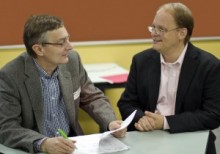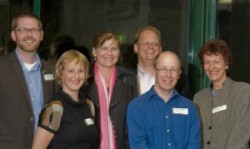Dr Ely Wallis, Museum Victoria and Robyn Lawrence, Atlas of Living Australia

Photo: Atlas of Living Australia

Photo: Atlas of Living Australia
The Biodiversity Heritage Library (BHL) digitises, stores and preserves the legacy literature of biodiversity online.
BHL is the literature service of the Encyclopedia of Life. By digitising biodiversity literature, the BHL project provides access to a wealth of information drawn from libraries across the world; material that in the past was only available in the printed form. This biodiversity literature can be historic; contained in books and journals well out of print and past copyright limitations. BHL also scans journals and monographs and makes them available online in pdf format, with an OCR version.
While the BHL began as an online resource for museum and herbaria libraries in the USA and UK, it has since extended to Europe and China and talks are underway to establish a South American node based in Brazil.
Australia has become BHL’s newest partner with the recent signing of a Relationship Agreement – similar to a Memorandum of Understanding – between the BHL, the Atlas of Living Australia (ALA) and Museum Victoria (MV).
The Australian node of the BHL is now available. For more information on the launch »
Visit the Australian Node at: http://bhl.ala.org.au/
Four representatives from the BHL in the USA visited Australia this month to meet with the Atlas team and Museum Victoria. They were Martin Kalfatovic, Deputy Project Director of the BHL and Assistant Director of the Digital Services Division at the Smithsonian Institution Libraries; Chris Freeland, Technical Director of the BHL and Director of the Center for Biodiversity Informatics at the Missouri Botanic Gardens; Phil Cryer, Senior Systems Engineer at the Missouri Botanic Gardens, and Anthony Goddard, Developer and Systems Administrator at the Woods Hole Marine Biological Laboratory in Maine.
The BHL, ALA and MV meetings focused on setting up a BHL Australia node with Australian content and analysing and resolving technical and usability issues such as sharing content, indexing, performance and styling. The Australian team will add its own look and functionality to the Australian BHL node.
A reception hosted by the Atlas of Living Australia in Canberra welcomed the visitors from the BHL USA and included the final signing of the Relationship Agreement by Dr Mark Lonsdale, Chief of CSIRO’s Division of Entomology and Martin Kalfatovic, Deputy Project Director of the BHL USA. The Relationship Agreement was also signed by Dr J. Patrick Greene, CEO of Museum Victoria and Dr Cristián Samper, Director of the Smithsonian National Museum of Natural History in the USA.
For more information, contact Donald Hobern at atlasoflivingaustralia@csiro.au.